Upon boot up Windows 8 opens to a lock screen.
This lock screen covers the log in information.
While this lock screen has been placed there as a
security measure it can add valuable second onto
your normal boot process. For this reason many users
prefer to disable the Windows 8 lock screen.
Disabling the lock screen requires a slight
tinkering in either the Local Group Policy Editor
(Pro version of Windows 8.1), or the Windows
Registry.
Method One - The Group Policy Editor
The Local Group Policy editor requires
Administrator permissions, therefore before
proceeding ensure that you are logged onto your
system as the Administrator.
Once logged on as Administrator proceed as
follows:
- On your keyboard press the Windows
key and the R key together to
open up the Run dialogue box.
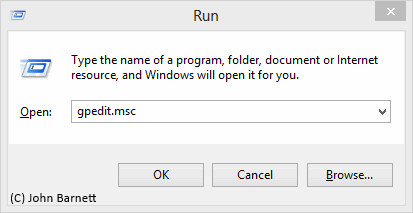
Fig: 8.7.1 In the Run box
type: gpedit.msc
- When the Run box opens,
type: gpedit.msc
- The Local Group Policy Editor will now open.
- In the Local Group Policy Editor window look
for the Computer Configuration section.
- Expand the Administrative Templates,
followed by the Control Panel
option.
- Once you have expanded the Control
Panel option, click on the
Personalization option.
- In the Main window look for the Do
Not Display the Lock Screen option and
Highlight it by clicking it with your mouse.
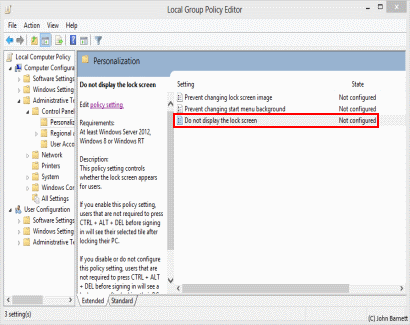
Fig: 8.7.3 Now click on the
Do not display lock screen option
- To the Left of the main window, click on the
Edit Policy Setting link. This
will open the policy for editing.
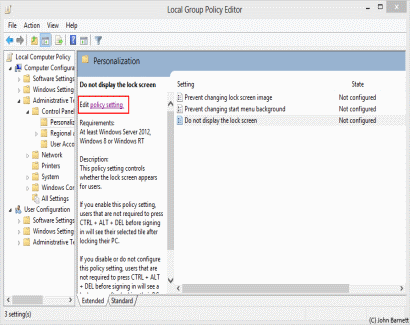
Fig: 8.7.4 Clicking the edit
policy settings will allow you to disable the
lock screen
- Click on the Enabled radio
button and then press the OK
button.
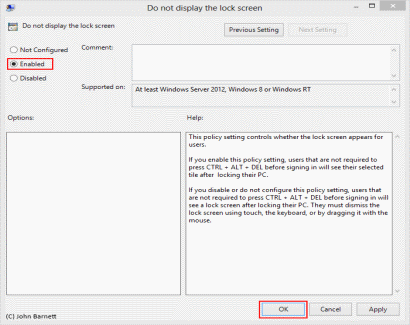
Fig: 8.7.5 Click the enabled
radio button to disable the lock screen
- Finally Close the Local Group Policy Editor
application.
- The next time you boot up your machine you
will be directed to the logon screen, thus
bypassing the lock screen.
- To Enable the lock screen once more, follow
steps 1 to 9 once more, but, on this occasion,
click the Not Configured radio button to
re-enable the lock screen.
Method Two - The Windows Registry
- On your keyboard press the Windows
key and the R key together to
open up the Run dialogue box.
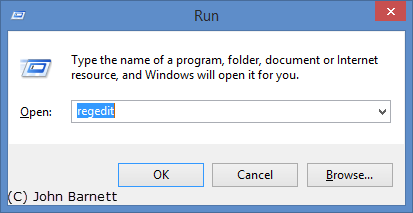
Fig: 8.7.6 Type regedit into
the Run dialogue box
- In the Run dialogue box type:
regedit
- Next press the OK button.
- The Windows Registry Editor
should now open.
- In the Registry Editor, navigate to the
following key:
HKEY_LOCAL_MACHINE\SOFTWARE\Policies\Microsoft\Windows\Personalization
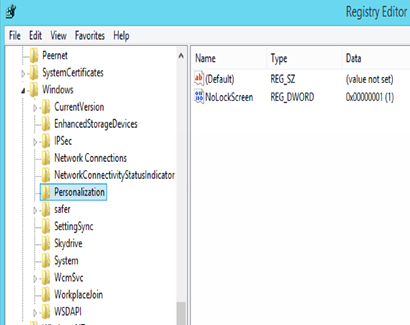
Fig: 8.7.7 Navigate to the
Personalization key in the Registry
- When you have opened the
Personalization key, if you look in the
right hand pane of the window
you should see an option called
NoLockScreen.
- Right click on the NoLockScreen
option and, from the drop down menu, Click on
Modify.
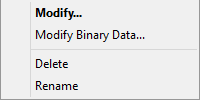
Fig: 8.7.8 Click on the
Modify button to make changes
- In the Edit DWORD box that
appear, change the Value data from 0
(zero) to 1 (one) and then
press the OK button.
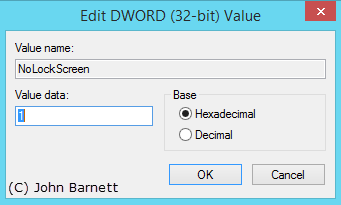
Fig: 8.7.9 Change value data
from 0 to 1
- You can now close the Registry
Editor.
- Your Lock Screen should now be disabled.
- If you wish to re-enable the Lock Screen,
simply follow steps 1 to 8 above. In the Edit
DWORD box change the data value back to 0
(zero).